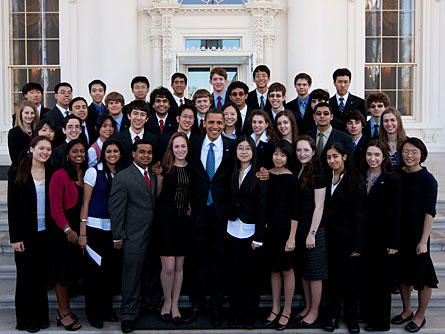- More than 2 years ago
WASHINGTON — It could have been the brainy version of American Idol — bright lights, fancy clothes and fanfare introducing America’s next top scientist.

Eric Larson, 17, of Eugene, Ore., won first place in the Intel Science Talent Search at a gala held the evening of March 10. Larson will take home a $100,000 scholarship from the Intel Foundation for his work exploring the mathematical concept of fusion categories. Fusion categories can have implications for string theory, quantum computation and knot theory.
Second place and a $75,000 scholarship went to William Sun, 17, of Chesterfield, Mo. Sun investigated a recently discovered molecule, golgicide A, as a potential drug to block the movement of bacterial toxins within cells. He showed that golgicide A targets a specific gene involved in intracellular transport and then pinpointed a mutation in the gene unique to canines that confers resistance to the drug. The work may shed light on neurodegenerative diseases.
Philip Streich, 18, of Platteville, Wis., took third place and a $50,000 scholarship for demonstrating the solubility of carbon nanotubes, graphene and cellulose nanocrystals, which could lead to new electronic materials. Streich’s work has resulted in five provisional patent filings.
Society for Science & the Public (formerly Science Service), publisher of Science News, has administered the competition since its inception in 1942. This year’s 40 finalists, winnowed from more than 1,600 entrants, represented 17 states and 35 schools. Over the past 67 years, Science Talent Search finalists have gone on to win seven Nobel Prizes, Fields Medals, the National Medal of Science and MacArthur Foundation Fellowships.
“Our generation can be proud of its advancements in science, but … our future may be following us,” says Elizabeth Marincola, president of Society for Science & the Public in Washington, D.C. “We pass the baton, and the truly tough problems, to the generation represented by our Intel STS finalists.”
The evening award ceremony included a special address by former Secretary of State Colin Powell, who reminded the finalists to always reach out to fellow citizens who don’t have the same opportunities and support networks. “When you reach down and keep a kid in school … when you touch a life like that, it will give you far more satisfaction than a bronze award.”The announcement of the winners capped the finalists’ weeklong visit to Washington as part of the Science Talent Institute. Exhibiting the results of their scientific projects at the National Academy of Sciences, the students explained and discussed their work to the public, the scientific community and, of course, the judges. But the high school scientists also had time outside the academy — including a visit to the White House to meet President Obama, meetings with their congressional representatives and a bowling excursion.
Steven Chu, Obama’s secretary of energy and a 1997 Nobel Laureate in physics, also addressed the audience. “Cherish what you have in terms of your talent and curiosity,” Chu said, applauding the “central noble intent of trying to understand nature.” Hat’s off to all of you and keep your love and interest in science.”
Fourth place went to Narendra Tallapragada, 17, of Burke, Va., for developing an efficient yet sophisticated method for modeling the building of materials atom by atom. Chelsea Jurman, 17, of Roslyn, N.Y., took fifth place for investigating the links among teens’ underage drinking, their perceptions of parents’ drinking and their parenting behaviors. Noah Arbesfeld, 17, of Lexington, Mass., won sixth place for efforts to understand the fundamental structure underlying all of algebra. Each of these students won a $25,000 scholarship.
Seventh through 10th place winners each were awarded a $20,000 scholarship. They are: Alexander Kim, 17, of Fairfax, Va., who investigated the genetics and evolution of several populations of the giant American river prawn; Preya Shah, 17, of Setauket, N.Y., for designing and synthesizing a drug that uses a two-pronged approach to target cancer cells; Nilesh Tripuraneni, 18, of Fresno, Calif., who formulated a set of hydrodynamic equations investigating quark-gluon plasma, a state of matter believed to exist right after the Big Bang; and Gabriela Farfan, 18, of Madison, Wis., whose analysis of the feldspar known as Oregon sunstone revealed unique microinclusions that contain zinc as well as copper.
Each of the remaining 30 finalists won a $5,000 scholarship and a laptop computer.
“At a time when our country requires innovation to spur economic growth, it is inspiring to see such talented young people using critical thinking skills to find solutions to scientific challenges,” says Craig Barrett, chairman of Intel Corporation, which is based in Santa Clara, Calif.







